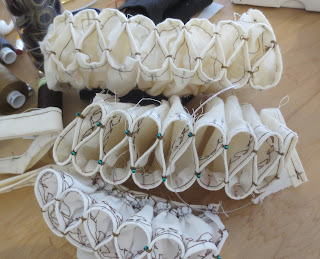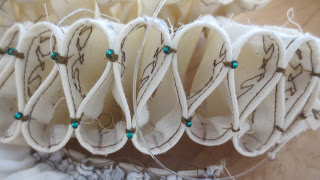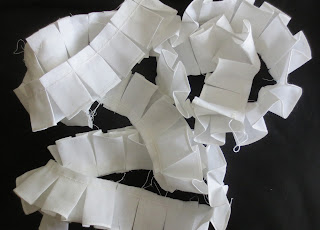Laundering them - because it was a mark of wealth to wear such white things - meant deconstructing, washing and starching, and then reconstructing - every time. Even a skilled 'ruffs 'n cuffs' person would have had a good day's work in the doing of it.
You always start with - samples. You try this, you try that, you try a third and a fourth and a fifth sample, until you finally settle on what (to you) looks best for your outfit. Making a sample also involves measurement - how many flat inches go into one pleated/gathered inch, and how many of the finished inches do you need?
Here are a few of the class's samples, demonstrating the two main techniques, box-pleating + gathering, or cartridge pleating (a whole 'nother world).
First: box-pleating + gathers result in honey-combs, particularly when you do a double row (pleats on two sides, gathers down the middle):
You can change the shape a bit by changing the pleating a bit, for example roses or swirls instead of honey-combs:
Cartridge pleating results in figure-8s, a shape enhanced when you sew fishing line into the edge as the one sample shows:
The pleats need to be exact - in the sample below, the figure-8s didn't work because the other end hadn't been kept exactly straight:
Decoration is the fun part - since each single pleat needs to be stitched another single pleat, there's real temptation to make that stitching part of the decoration. That can mean something like 280 beads per ruff (estimate for the second sample below), if you decide on beads:
A lot of yardage goes into them - very normal is a ratio of 20 flat inches to 1 gathered inch. My design choice was relatively conservative: around 94" flat for a 17" neck ruff, around 135" flat for an 11" cuff. Yes - more inches for the smaller length, but that's likely because my neck ruff is made doubled and so more easily looks fuller. Here's my sample pinned on to the doublet:
Here's what my 'ruff 'n cuffs' look like flat, waiting for the pleats to be sewn and then the whole thing gathered (my weekend task):











No comments:
Post a Comment